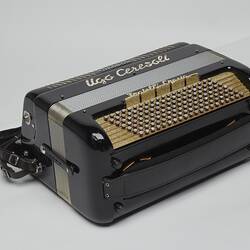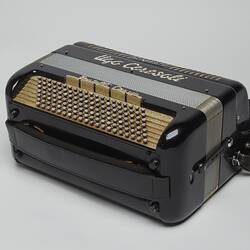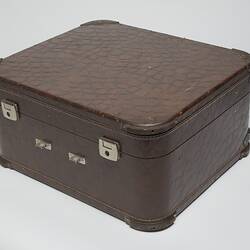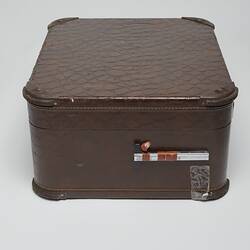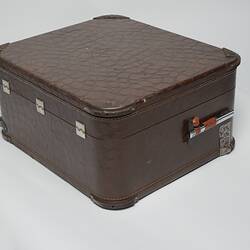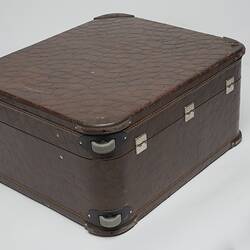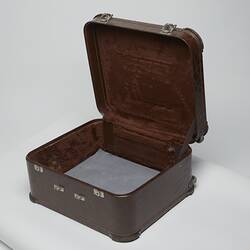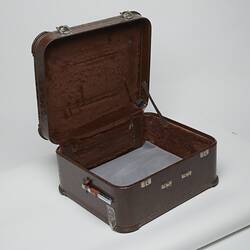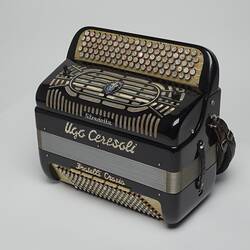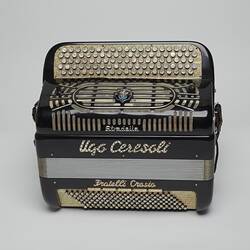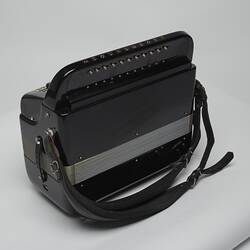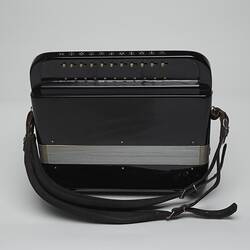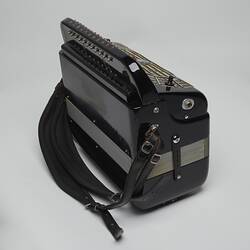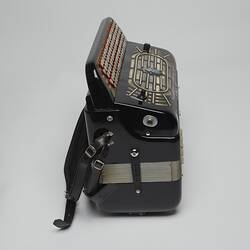Summary
Button accordion with case, belonging to Ugo Ceresoli. The accordion was manufactured by Fratelli Crosio, Stradella, Lombardy, Italy. Possibly bought to Australia by Ugo Ceresoli when he arrived in 1952.
It is part of a collection of over 50 pieces which includes a button accordion, seven music stands, posters, scrapbooks, and digital photographs.
Ugo Ceresoli (1927-1996) emigrated from Italy to Australia, arriving in Melbourne in late 1952 on the 'Oceania'. Ugo was 25 years old and was an accomplished dance musician and accordionist. Reunited in Melbourne with his brother Bruno, they formed an Italian music band in Carlton, an inner suburb of Melbourne amidst a growing post-War Italian migrant community. In about 1953 they named their dance band 'Mokamba Orchestra' and performed Italian and Latin and other music styles for increasingly cross-cultural Melbourne audiences. They also appeared on radio and TV. Bruno died in 1970, but Ugo, joined by his wife Jo Muhrer (Laurance), a singer, continued perforrming with Mokambo Orchestra for over 40 years.
Physical Description
Black, hard plastic button accordion with rounded brass buttons, covered with a mother of pearl- like finish. There are two keyboards on each side of the accordion, both have an applied gold sparkle finish. Along the edges of the accordion there are pieces of metal which are attached to adjustable leather straps, lined with black padding.The bellows, at the centre of the accordion, are red cloth edged with silver metal. There is a rectangular black leather handle on the right side of the accordion [viewed from the front when resting on its feet]. The owner's name, Ugo Ceresoli, is painted on the top of the accordion, next to the bellows. His name is painted in white enamel in a cursive font and studded with eight-five imitation diamonds. The name of the accordion manufacturing company, 'Fratelli Crosio', is painted on the other side of the bellows in cursive, cream font with seventy-five imitation diamonds [five missing]. The name of the place of production, 'Stradella', is given in cursive script in silver pressed metal and adhered above Ugo Ceresoli's name. The 'Fratelli Crosio' logo is featured on the top of the accordion. It is multi-coloured, picturing a man in a multi-coloured outfit playing a black and white accordion, whilst standing on a globe orientated to place Italy in the center, above the word 'STRADELLA'. There are four hard plastic feet on the bottom of the accordion. The accordion is housed in a 'Mobil Organ Brevett.' burnt umber coloured, rectangular case with imitation crocodile skin and yellow nylon coated stitching. There are four 'Mobil Organ Brevett.' logos in each corner of the case, embossed with a hand holding a case with 'MOBIL ORGAN' and 'BREVETT.' underneath. There are two grey wheels on the bottom right and left hand side of the case and metal locks with key holes. There is a metal handle with extendable black plastic on the top of the case with red tape wrapped around the handle. The inside of the case is lined with brown imitation fur.
Significance
Statement of Historical Significance:
The Ugo Ceresoli and Mokambo Orchestra Collection documents the rising popularity of Italian-Latino music following mass Italian migration to Australia post-World War II. The collection provides invaluable insights into the experiences of those who migrated from Italy when faced with political, social and economic uncertainty in their country and a demand for white European labour in Australia.
While representing a post World War II migrant narrative of two young men from Italy settling in Carlton, it also explores broader themes of the establishment of a Carlton Italian community; the forging of small businesses in the 1950s and 1960s; and the thriving music and entertainment scene in Melbourne. The formation of numerous 'Italian-Latino' bands playing ballo italiano music led to this style being popular with both Italian communities and the broader public, contributing to an increasing admiration for Italian culture. The Mokambo Orchestra and its associated activities covers a period of over thirty years and was an integral part of the growing Italian community within inner Melbourne.
The collection comprises over 50 items donated by the Ceresoli family which have extensive research potential. It includes photographs, scrapbooks, newspaper articles, personal correspondence, a songbook, as well as one of Ugo Ceresoli's accordions and several of the orchestra's music stands. The collection is of broad social and political significance and reflects Australia's widening national identity. Many items in the Ugo Ceresoli and Mokambo Orchestra Collection are well provenanced to other well-known Italian-Latino bands, Italian musicians and other heritage collections, most notably the Italian Historical Society CO.AS.IT collection in Melbourne.
More Information
-
Collection Names
-
Collecting Areas
-
Acquisition Information
Donation from Ms Melinda Ceresoli, 03 Oct 2013
-
Owner of Item Depicted
-
Inscriptions
Button accordion: Inscribed in white cursive writing: 'Ugo Ceresoli'. Inscribed in cream cursive writing: 'Fratelli Crosio'. Inscribed in silver cursive writing: 'Stradella'. Multi-coloured logo: Picture of a man in a multi-coloured outfit playing a black and white accordion, whilst standing on a globe orientated to place Italy in the center, above the word 'STRADELLA'. Accordion case: Four 'Mobil Organ Brevett.' logos in each corner of the case, embossed with a hand holding a case with 'MOBIL ORGAN' and 'BREVETT.' underneath.
-
Classification
-
Category
-
Discipline
-
Type of item
-
Overall Dimensions
580 mm (Length), 500 mm (Width)
-
Keywords
Entertainment Industry, Entertainment Venues, Entertainment Workers, Performances, Performers, Performing Arts, Music Band, Music Performances, Singing, Italian Communities, Musical Instruments, Accordions

